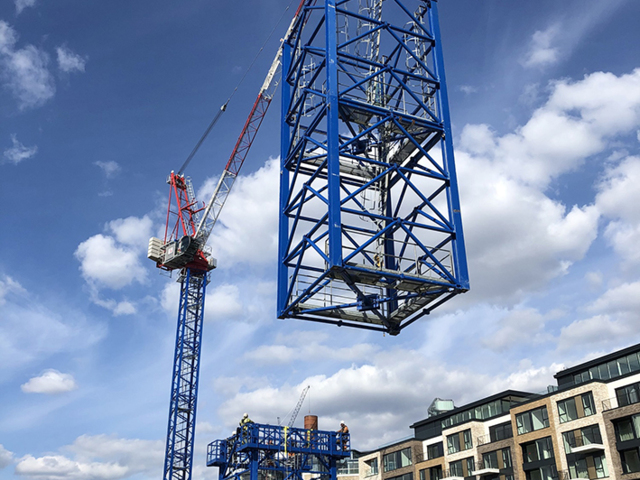This will be the tallest freestanding luffing jib tower crane known to be in operation currently in the UK.
The height is not extraordinary for a crane, with tower cranes that are tied to buildings going to much greater heights than this. However, the crane is unique at this height because it is freestanding and a luffing jib crane.
The first phase of erection took place with the help of a 350 tonne mobile crane at the beginning of May at Chelsea Creek, in Fulham, where a selection of one, two and three bedroom homes is being built by St George, part of Berkeley Group.
The LR 213 currently has a 55m mast for the initial construction phase – the final height of the crane will be 105m later this year as the buildings reach 32 storeys. Typical freestanding luffing jib cranes would be between 30 – 60 metres tall for residential developments, with some occasionally reaching 70 metres or more, however there are none known to be operating in the UK freestanding at over 100 metres.
In anticipation of the final height, the large base specific to this job has already been concreted into place. The photos convey just how big the base is, with what would be a normal mast looking small in comparison on top of it. Typical tower bases for tower cranes are 1-2m squared, however this tower base is 4.5m squared to give enough stability for the crane to withstand the forces at such a tall height.
Edward Seager, Managing Director of Bennetts Cranes, explains: “When you double the height of a tower crane, the forces don’t just double, they square. Further to that, the wind is stronger the higher you go and so, the taller the crane the more force upon it from the wind. The tower that has been installed for this crane is very large, and needs to be extremely strong for the 105m mast.”
Mr Seager explained that over the last few years there has been a steady trend towards using taller freestanding cranes, driven by changes in cladding systems, which has meant it is difficult to apply cladding while the crane is tied to the building.
Mr Seager added: “Developers also favour freestanding cranes because they give more flexibility on site, and result in a quicker build time because you don’t need to climb the crane and tie it to the building – the cladding can be put on as the building is constructed, rather than waiting for the cranes to be removed.”
The LR213 has been joined onsite by the LR273, one of Raimondi’s newest luffing jib cranes with an 18 tonne maximum load capacity.
Photo: The tower base of the LR213 being lowered into place by the Raimondi LR273


